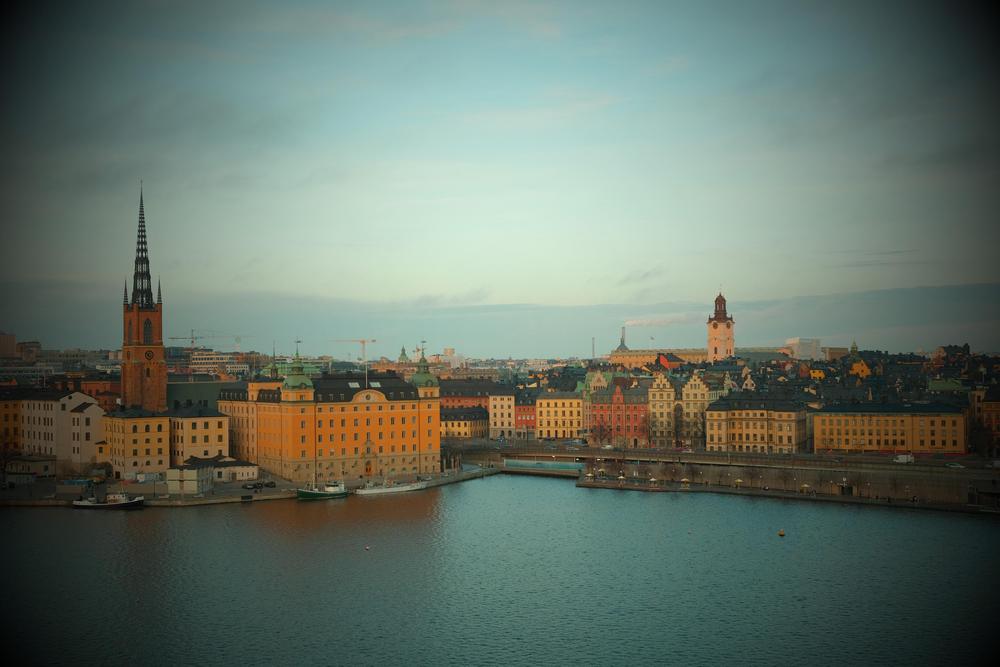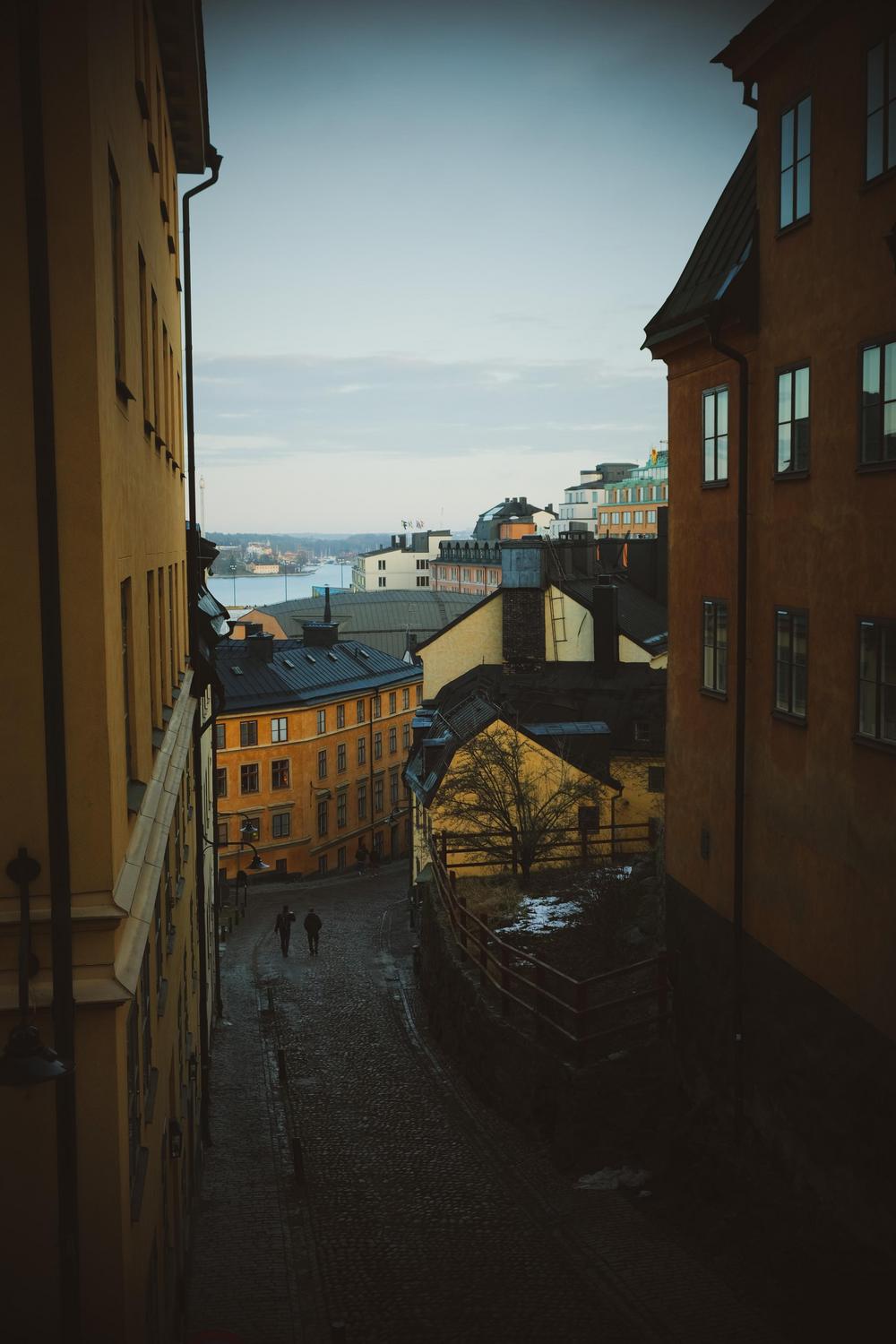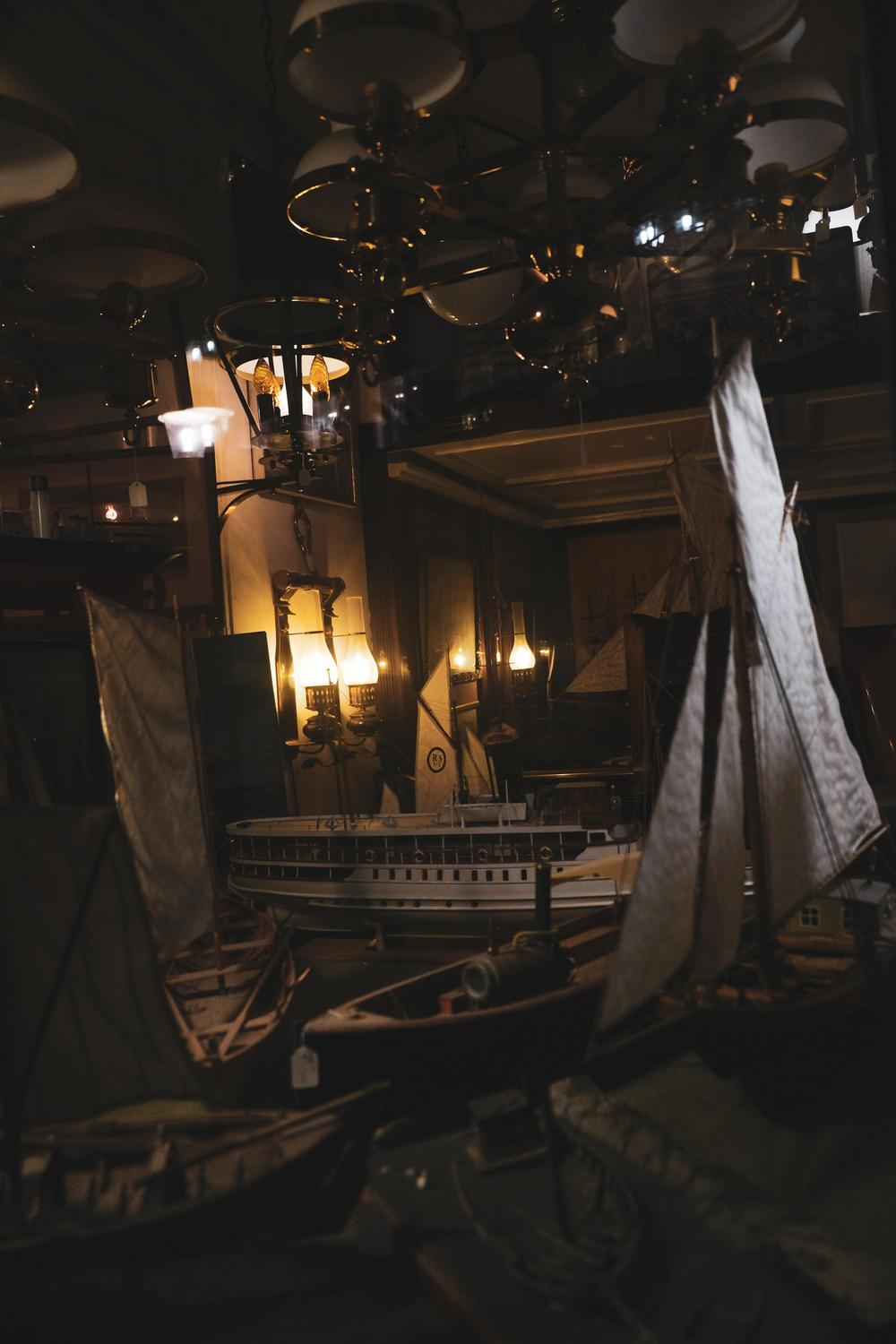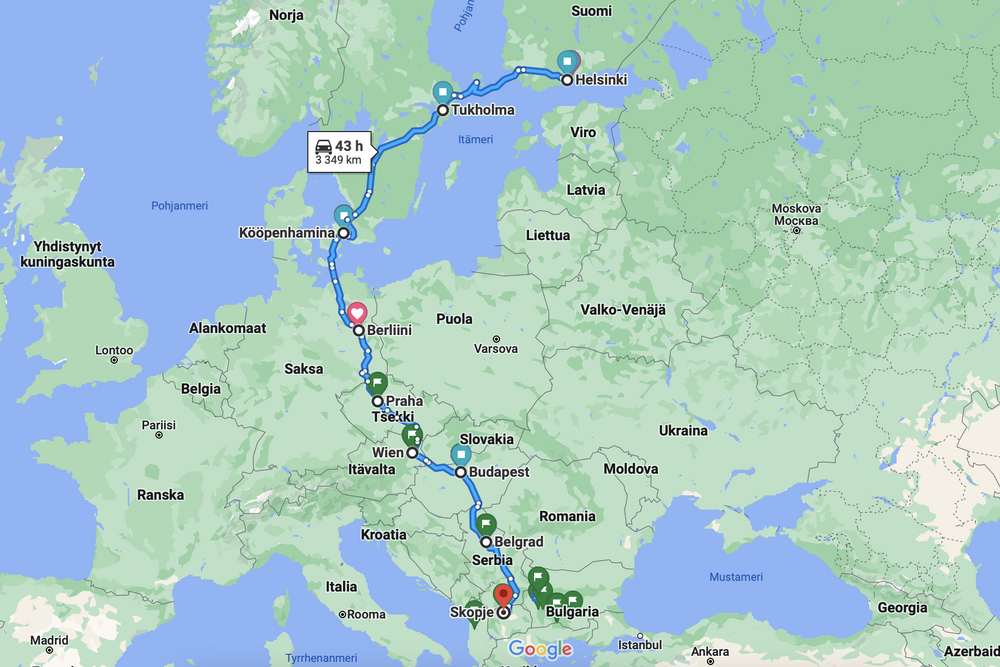Experiences on sustainable travel
Content of this page:
In this section you can read other people's experiences of traveling by land.
- Lisa's account of her journey to Brussels and back by land and sea.
- Annika's travel from North Macedonia back to Finland by land.
If you are longing for travel accounts in Finnish, you can find them here:

View of Stockholm from Mariaberget - Picture taken by Lisa
Green travelogue. Lisa’s journey to Brussels and back
Ciao!
My name is Lisa, I am a long-term ESC volunteer with Allianssi Youth Exchanges and an irredeemable wanderer. Not even a week had passed since I relocated from Italy to Helsinki when I found myself hitting the road to Brussels for the kick-off meeting of the European Youth in Action project: https://www.nuorisovaihto.fi/allianssi-youth-exchanges/projects-and-exchanges/eya-european-youth-in-action/
As a climate activist, my love for travel often feels at odds with flying, so I opted for a greener alternative: ferry and train travel. This journey brought plenty of surprises, from start to finish—and especially towards the end, as you will read...
A Berth of One’s Own
Maybe it’s just me romanticizing my life, but the idea of starting my journey with a sail to Stockholm sounded appealing, despite my seasickness. All “land” travel from Helsinki actually begins at sea, with ferries departing from either Helsinki or Turku and reaching Stockholm or Tallinn. Since I was heading to Western Europe, I took the ferry to Stockholm.
I chose to take a bus from Helsinki to Turku instead of departing directly from Helsinki because this option was cheaper, especially with the affordable tickets offered by Onnibus.
I boarded the ferry with a bag full of medications, remembering my past experiences where seasickness hit me hard. Kwells travel sickness tablets had saved me on those occasions, but this time, to my relief, the trip went smoothly. The sea was calm, the ferry huge, meaning also less vulnerable to stormy weather, and since it was a night ferry, I spent most of the trip sleeping.
Another stroke of luck: Both on the way to Stockholm and back, I ended up in a private cabin, despite having booked a cheaper shared berth. I guess this often happens when traveling in low season, when there are plenty of available spots. Once in my cabin, I enjoyed the dinner I had brought from home – for an Italian, the schiscetta, a homemade packed meal, is an essential travel companion!
However, if you plan to bring your own food or drinks on the ferry, check the rules! Tallink allows food and beverages from outside, but Viking Line doesn’t. Both the ferries have cafes and restaurants but they are quite expensive.
Interrail
For the land portion of my trip, I used an Interrail pass, which offers discounts for people under 27. This pass allows unlimited train travel on most trains for a specific number of days, but some, like high-speed or night trains, require booking in advance for an additional fee.
If you choose an Interrail pass, I highly recommend downloading the app. It’s super helpful for planning your travels and getting real-time updates about train delays or cancellations. That said, not all train options appear on the app, so it’s worth doing extra research if you don’t find what you’re looking for.
My journey to Brussels went smoothly, especially compared to the return trip. After arriving at Stockholm’s Tallink terminal in the early morning, I headed to Stockholm Central for breakfast, having to walk for a while because the ferry terminal isn’t close to the train station.
From Stockholm Central, I took a SJ high-speed train to Copenhagen, where I arrived in the afternoon. Side note: Copenhagen Central Station is gorgeous!
From there, I hopped on another train to Hamburg, where I spent the night at the Generator Hostel, conveniently close to the station. Generator is a hostel chain across Europe that I recommend –especially during low season when the prices are lower. I paid just 13 euros for a bed in a six-person dorm, and I booked only a week in advance. The hostel has spacious, modern common areas, though it didn’t have a kitchen, so I had to eat out.
DB: The Dark Side of Green Travel
Unfortunately, Deutsche Bahn (DB), Germany’s rail system, is infamous among Interrailers. I had heard the horror stories, but my last experience with DB had been smooth, so I wasn’t too concerned. Well, I should have listened…
The weekend I traveled, things went awry across all of Western Germany. My friend and I were supposed to travel to Hamburg via Düsseldorf, but on the Friday of our trip, all trains to Düsseldorf were canceled and replaced with slow buses. These buses wouldn’t have gotten us to Hamburg in time to catch our 10 PM night train to Stockholm.
After a quick check on the Interrail app, we decided to reroute through Amsterdam. That’s one of the perks of Interrail—its flexibility makes last-minute changes easy. We caught a train from Amsterdam, which was supposed to stop in Osnabrück, Germany. To our surprise, the train passed straight through Osnabrück without stopping. Following the recommendation of the train staff, we had to disembark at the next station, then travel back to Osnabrück. We suspect the train officers made an announcement, but it was in German only, even though the train had departed from Amsterdam.
To top it off, all trains to Hamburg were delayed by at least an hour, meaning we missed our night train to Stockholm. To stand up for our cause, we went to the DB info point, where we were offered a hotel for the night. However, we couldn’t accept because staying in Hamburg would have meant missing our ferry in Stockholm!
We insisted we had to reach Denmark that night, and DB arranged a more than three-hour taxi ride to Fredericia, Denmark. We arrived to Fredericia at 3:20 AM and waited in a cozy room at the station until 4 AM, when we boarded a train to Copenhagen. From there, we changed trains in Malmö and finally made it to Stockholm.
We arrived exhausted, but we still managed to enjoy the Swedish sunshine and indulge in some delicious kanelbullar (cinnamon buns) before catching the ferry back home. And most importantly, now we can boast that we got on a three-hour taxi ride for free!

Street in Södermalm, Stockholm - Picture taken by Lisa

Miniatures shop in Gamla Stan, Stokcholm - Picture taken by Lisa
Annika's travelog: traveling by land from North Macedonia to Finland
"Hi, my name is Annika! I spent two months volunteering in Macedonia, at the Volunteer Center Skopje. Prior to leaving for my volunteer period in Skopje, I knew I wanted to make the return trip home by land. A trip through many countries requires planning, and a little more time, but can be a wonderful adventure. In this travelog, I will share my experiences from the trip and share some tips for planning the trip.

Itinerary: duration and planning of the trip
I traveled through a total of seven countries. I started the journey from Skopje by bus to Belgrade, from where I continued my journey to Budapest and from there to Vienna and Prague. From Prague, I continued via Berlin, Copenhagen and Stockholm and finally by ferry to Finland.
I traveled from one city to another mainly by bus. I was using Flixbus and RegioJet buses, and according to my experience, they are relatively comfortable and well-equipped, so even longer trips can be quite comfortable. It's especially nice if the bus is not very full and I can occupy a row of seats all to myself. The journey from Budapest to Vienna was quick, comfortable and even cheaper by train. The second train trip was from Copenhagen to Stockholm.
Prices vary a lot, but usually bus trips are very affordable. Even for short distances, trains are usually reasonably priced and even faster. So you should weigh the price-quality ratio when booking trips. I personally bought individual travel tickets, for example, instead of an interrail pass. I booked the trips mainly through Omio, where you can compare the prices of train, bus and ship tickets. Sometimes, however, it's worth browsing the train companies' own pages, for example, because the prices can be even cheaper.
The journeys between Budapest-Vienna-Prague-Berlin went quickly by train. The journey from Budapest to Vienna took 2.5 hours and from Vienna to Prague just under 5 hours. Berlin can be reached by bus from Prague in 4.5 hours. The longest distances were Skopje-Belgrade-Budapest. It took 7.5 hours to travel from Skopje to Belgrade and 6 hours from Belgrade to Budapest. You can get from Berlin to Copenhagen by bus in 8 hours. In Copenhagen I decided to take the train to Stockholm and the travel time was 5.5 hours. The only way to travel from Stockholm to Helsinki is by ship, which was the longest and most expensive single trip of the trip. The trip lasted a day and cost around 80 euros with a cabin.
Another option for the route would have been to continue from Budapest through Slovenia to Poland and through the Baltic States to Finland. However, it seemed more meaningful to do the route another season. By traveling through Vienna, I got to know cities that were previously unknown to me. During my own trip, the connections to Slovenia were also not to my liking, so the choice was easy. It is also easy to continue from Vienna to Warsaw and make the journey home via the east, if you wish.
Tips for overnight stays along the way
I expected my trip home to be a couple of weeks, because I wanted to travel slowly. However, this practically meant staying in each destination for a maximum of two nights. At this time, however, there is plenty of time to rest and there is at least one whole day left for sightseeing. You can find really clean and comfortable places to spend a couple of nights in the city center and just outside it. I stayed in hostels whose prices ranged from 16 to 25 euros per night. The prices are not the cheapest, but considering the comfort of hostels, they seemed reasonable. You should make sure that the hostel has a kitchen to prepare your own meals if you don't want to eat out. In addition, you can meet other travelers in hostels, from whom you can get tips on what to do in the city and have company. However, if you want to save money and get to know the locals, you should look for a place to stay for the night through Couchsurfing.
What else can be done along the way?
Personally, I always go to a new place on a free walking tour, where payment works on a drop-in basis. At the end of the round, you can pay what you want. The tours are about a couple of hours long and are great for getting to know a new city. The guides are always really nice and do their job with passion. In Budapest, you should definitely visit a spa to relax. Gellert is one of the finest and most popular, and is definitely worth a visit. In the Rudas spa, on the other hand, there is an opportunity to soak in the hot water even at night. The entrance ticket is around 20 euros and for this price you can spend a whole day in the spa. You should try the Hungarian food Goulash and you can also find it in a vegan version at, for example, the Napfényes restaurant, which I definitely recommend!
Since I was on the move during the Christmas season, there were great opportunities to visit the Christmas markets and drink mulled wine. Especially in Vienna, the Christmas markets are big and full of things to go around. Vienna also has a huge cultural offer, the hardest part is choosing which exhibition or concert you would like to go to. On the Prague stage, I decided to take the trip much more relaxed. The first evening, I took a leisurely walk in the city and rested in the hostel. In Prague, you should definitely go to the flea markets, because there are a lot of them and they are really good!
I only had a few hours in Copenhagen, but I had time to visit Huset-KBH in the center. The cultural center has e.g. cafes, concerts and a cinema. You can visit the place for a coffee before heading to the next place. Next, I headed from Copenhagen to Stockholm. The trip had mostly gone very smoothly. Only in Copenhagen was there a problem with the train connection and I had to take an earlier train to get to Stockholm. I arrived there in the evening and the next day the journey continued immediately by Ferry back to Helsinki.
The cost of the trip
The final amount of the travel expenses for the stages between the seven cities came to a total of approximately 290 euros. The most expensive part of this amount was the ship trip from Stockholm to Helsinki, which cost a total of 80 euros with a cabin. On the other hand, if you travel via the Baltics, the ferry trip from Tallinn to Helsinki usually costs less than 20 euros and takes only a couple of hours.
The total cost of accommodation for the trip came to about 250 euro. The sum consists of a total of two weeks' accommodation, of which I spent two nights in a more expensive hotel in Belgrade, which increased the total amount. I didn't count food expenses much during the trip. You can eat very inexpensively by preparing your own food in the hostel's shared kitchen. If you want to eat out, it is very cheap to eat in a restaurant in, for example, Belgrade, Budapest and Prague. You can easily find portions for less than 10 euros. You can keep your daily food budget under 20 euros if you cook some of your food yourself and eat out, for example, once a day. Vienna, Berlin, Copenhagen and Stockholm, on the other hand, are already significantly more expensive cities and the price level is pretty much the same as Finland.
Safety
In my opinion, there is no need to worry about safety during the trip. I have mostly traveled alone and according to my experience, traveling in Europe is very safe. You should find out about the destination in advance, and if you wish, you can check the security situation by reading the travel bulletins of the Ministry of Foreign Affairs. You can do well with common sense and basic measures. In the evenings, you can avoid remote and dark routes, and if you go out to spend the evening with, say, a group you met in a hostel, you should return to the hostel together with someone you know from the group. Sometimes there can be pickpockets in the most popular tourist destinations and areas with a lot of people. You should take care of your belongings. I personally keep, for example, my wallet and phone in my belt bag or jacket pocket.
General tips for the trip
If you are planning a trip by land, you must also plan the amount of luggage accurately. I was traveling with a large suitcase, which made it difficult to drag along and sometimes slowed down the journey. On the other hand, this didn't bother me too much, because I had decided to make the journey without haste and adapting to the conditions.
Remember that you should not be afraid of problems. They will most likely come at some point along the way. Something can get lost on the way, the hotel can't find your reservation, or the battery runs out in a critical place. However, people are almost always ready to help and situations do find a solution.
Travel documents should be scanned and stored in the cloud or printed. I always have a copy of my passport, European medical card and other important documents with me.
It is also important to look carefully if the travel ticket needs to be printed. In the Balkans, I was able to exchange my mobile ticket for a paper one at the information desk, so there is no need to worry about printing. At the same time, you can ask which platform the train or bus leaves from. At all stations, schedules cannot be checked on the screens.
Please note that some bus stations ask for payment before entering the platform. That's why it's worth carrying at least a small amount of local money.
I always carry a few things that are useful when traveling:
- Lunch. Vegetarians and vegans should bring their own snacks, because the stops do not always offer vegetarian options. Fortunately, European cities usually offer numerous good vegetarian restaurant options. You can look for vegetarian restaurants for example in the HappyCow application.
- Power bank. On long bus or train journeys, you can't always charge your phone and it's miserable if the battery runs out when you should know how to navigate to the right hostel.
- Paper and hand towels. Toilets at gas stations and buses almost always do not have toilet paper, let alone proper hand washing facilities. That's why it's a good idea to keep a small amount of paper with you.
- Book/magazine, etc. Carry something to do that does not require an internet connection, as it may not work while traveling.
- In some places, you may have to buy drinking water in a store. In many hostels, you can get drinkable water from the tap, and I filled my own bottle during my stay, and especially for the next train or bus trip.
- You should definitely get to know the locals and other travelers. I have made wonderful new friends and spent really nice evenings together with other travelers.
To Summarize, the trip was really wonderful. Seeing new places is refreshing, coming home felt wonderful and rewarding after a long journey. Although I have traveled in Europe without flying before, this was my first long trip by land. You learn more from each trip and making the next trip only becomes easier. I think traveling by road is much more interesting and rewarding than flying. Emissions from air travel are also significantly more burdensome on the environment than traveling by train or bus.